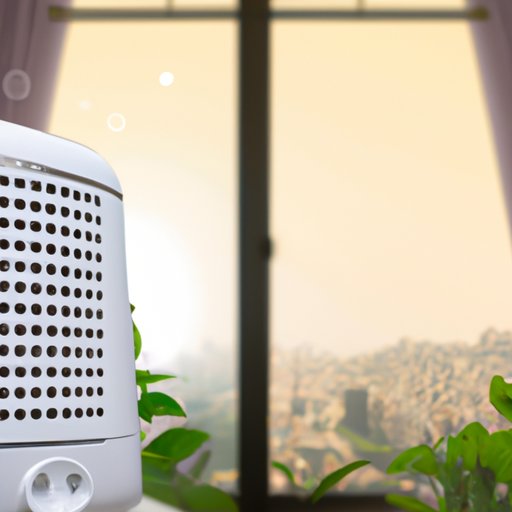Introduction
Air purifiers are electronic devices designed to remove pollutants from the air in a home or office. They come in a variety of shapes and sizes, and use filters and other technologies to reduce the levels of airborne particles such as dust, pollen, smoke, and pet dander. While air purifiers can be an effective way to improve air quality, there are potential health risks associated with their use that should be considered before purchasing one.

The Use of Ozone Generating Air Purifiers and its Health Risks
Ozone is a naturally occurring gas that has both beneficial and harmful effects on the environment. It can help to reduce air pollution when present in the upper atmosphere, but at ground level it can irritate the lungs and aggravate respiratory conditions. Ozone-generating air purifiers use ultraviolet light to produce ozone, which is then released into the air in order to eliminate pollutants. However, this can have negative health effects, particularly for people who suffer from asthma or other respiratory conditions.
Exposure to ozone can cause coughing, wheezing, chest tightness, and difficulty breathing. It can also worsen existing respiratory conditions and may lead to more frequent and severe asthma attacks. People with heart disease may experience increased risk of heart attack and stroke when exposed to elevated levels of ozone.
To avoid these potential health risks, it is important to choose an air purifier that does not generate ozone. Many air purifiers are labeled as “ozone-free” or “ozone-safe”, so look for these labels when shopping for an air purifier.
Potential Allergen Exposure Through Air Purifiers
Allergens are substances that can cause an allergic reaction in some people. These can range from pollen and dust mites to pet dander and mold spores. Air purifiers can help to reduce the levels of these allergens, but if not used correctly, they can actually spread them further into the air.
It is important to choose an air purifier with a HEPA filter, as these are designed to capture and remove even the smallest particles from the air. Additionally, it is important to regularly change the filter to ensure that it is working effectively. Finally, it is important to keep windows and doors closed while using an air purifier to minimize the potential for allergen exposure.
Off-Gassing and Volatile Organic Compounds Released by Air Purifiers
Off-gassing is the release of volatile organic compounds (VOCs) into the air. These compounds can include chemicals such as formaldehyde and benzene, which can have negative health effects when inhaled. VOCs can be released from air purifiers, either through the filter material or the plastics used to make the device.
To reduce the potential for VOC exposure, it is important to choose an air purifier made from non-toxic materials. Additionally, it is important to regularly clean and replace the filter to reduce the amount of off-gassing. Finally, it is important to ensure adequate ventilation in the room where the air purifier is being used.
Microbial Contamination from Inadequate Filters in Air Purifiers
Microbial contamination is the presence of bacteria, viruses, and fungi in the air. Poorly maintained air purifiers can contribute to this contamination by failing to remove these particles from the air. To reduce the risk of microbial contamination, it is important to regularly inspect and clean the filter to ensure that it is functioning properly.
Additionally, it is important to choose an air purifier with a high-quality filter that can effectively remove particles from the air. HEPA filters are recommended for this purpose, as they are designed to capture even the smallest particles.

Poorly Designed Air Purifiers Can Spread Particles Rather than Remove Them
While most air purifiers are designed to remove particles from the air, poorly designed models can actually increase particle levels by spreading them further into the air. This can be caused by a faulty fan, inadequate filter, or poorly sealed casing. To avoid this, it is important to select an air purifier with a strong fan and a tightly sealed case.
Additionally, it is important to read reviews and compare different models to ensure that the air purifier you choose is effective at removing particles from the air. Finally, it is important to regularly check and replace the filter to keep the air purifier running efficiently.

Noise Pollution from Air Purifiers
Air purifiers can also contribute to noise pollution, as many models are quite loud. To reduce noise pollution, it is important to select an air purifier with a low decibel rating. Additionally, it is important to place the air purifier in a room that is well insulated and away from areas where noise will be disruptive.
Finally, it is important to make sure that the fan speed is set to the lowest setting possible. This will reduce the noise output of the air purifier without compromising its effectiveness.
Conclusion
Air purifiers can be an effective way to improve air quality, but there are potential health risks associated with their use. These include exposure to ozone, allergens, and volatile organic compounds, as well as the potential for microbial contamination and noise pollution. By following the tips outlined above, you can reduce the potential for these health risks and enjoy the benefits of cleaner air.
(Note: Is this article not meeting your expectations? Do you have knowledge or insights to share? Unlock new opportunities and expand your reach by joining our authors team. Click Registration to join us and share your expertise with our readers.)
